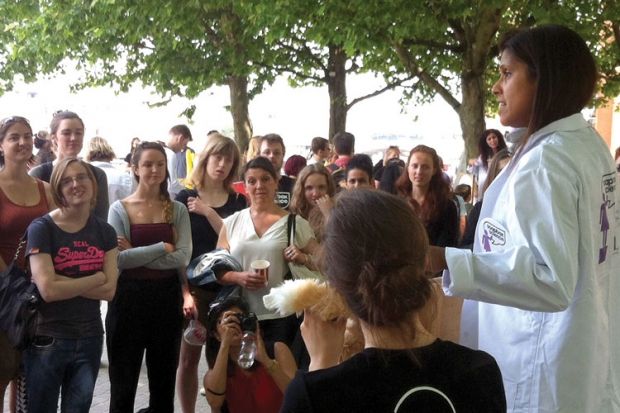Role models: female scientists make their presence felt in a male-dominated field
London’s South Bank often plays host to entertainers trying to persuade tourists to part with their cash. But last week it became the domain of female researchers, who got on their soapboxes to boost awareness of women in science.
The annual Soapbox Science event, now in its third year on the South Bank, is designed to make women in research more visible to the public and within the profession.
It works in part by creating a network of women scientists and publicising their concerns. But it also aims to subtly change public perceptions of women in science by creating an event that is dominated by female scientists – without overly advertising that fact.
So for more than three hours on 5 July, 12 female scientists spoke to passers-by on a range of subjects, from brain science to quantum computers, as well as fielding their many questions.
“I’m not sure many of the people even clocked that it’s all women,” said Ravinder Kanda, a research associate at the University of Oxford who spoke on genome invaders.
The project was founded by Nathalie Pettorelli, research fellow at the Zoological Society of London, and Seirian Sumner, senior lecturer in behavioural biology at the University of Bristol, both of whom have won L’Oréal-Unesco Women in Science UK fellowships.
Dr Pettorelli said that the hurdles commonly faced by women in science, and female researchers’ lack of visibility, were well known.
“A lot of people talk about it but not many people actually do anything about it,” she said. “This raises their visibility instantly…And if you raise your profile enough, you may eventually be listened to by the right people.”
The “street performer” format also has the benefit of drawing in people who would not normally choose to go to a science fair, Dr Sumner said. “It’s not only a message about women in science; it’s a creative way of doing it.”
The event is growing in success, with scientists now having to compete fiercely for soapbox slots and organisers fielding requests to host the event elsewhere in the UK – something they said that they would like to do with additional support.
Data collected at the event show that spectators stay to listen, on average, to 20 minutes of any single speech, proving that the public is genuinely engaged by the project, said Katy Gandon, head of external affairs at L’Oréal UK and Ireland, whose Women in Science programme supports the event alongside the ZSL.
Zoe Schnepp, fellow in chemistry at the University of Birmingham who was speaking on superconducting seaweed, said that she was attracted by the idea of standing like “a street entertainer” and having to capture the attention of passers-by.
She noted that there are no female professors of chemistry at Birmingham, and added that it is important to show that women can “go really far” and “become world leaders” in science.
Members of the audience also seemed to be impressed with the project.
Tjark Ziehm, visiting from Germany, said that he had not noticed at first that all the speakers were women. “It was just normal…for me it’s a good thing,” he said.
Meanwhile, Karalyn Colopy, a mother who brought her two daughters to the event after seeing it advertised online, said: “I’d love for them to see women who are practising science and to be inspired by it.”
Register to continue
Why register?
- Registration is free and only takes a moment
- Once registered, you can read 3 articles a month
- Sign up for our newsletter
Subscribe
Or subscribe for unlimited access to:
- Unlimited access to news, views, insights & reviews
- Digital editions
- Digital access to THE’s university and college rankings analysis
Already registered or a current subscriber? Login




